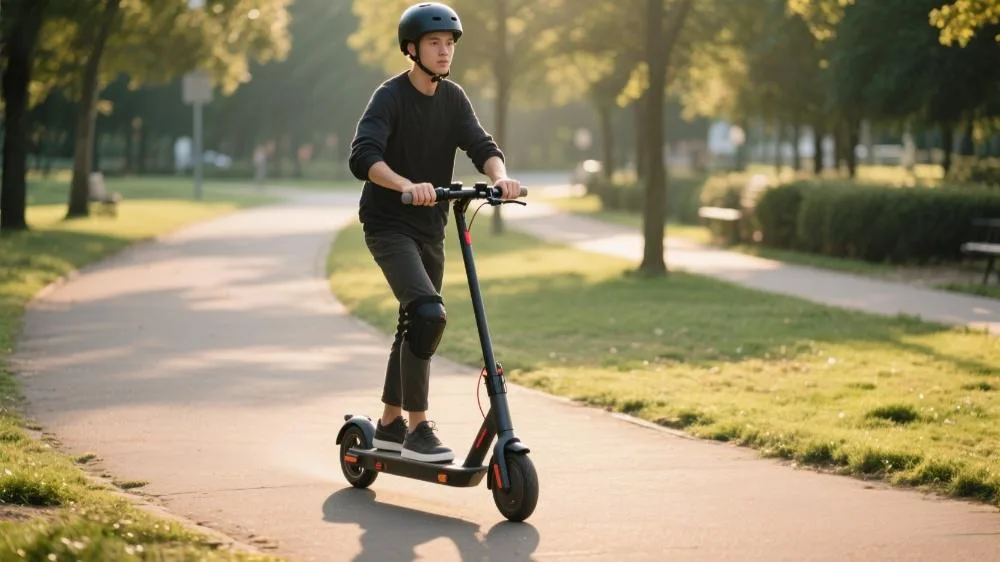how to ride an e-scooter

According to the European Urban Mobility Institute’s 2025 Micromobility Development Report, e-scooters have become Europe’s fastest-growing personal transport mode with 37% annual growth. Professional content platform Novascooter’s user research reveals 82% of Western riders use e-scooters for daily commuting, yet only 56% have received formal safety training.
How to ride an e-scooter? WHO’s 2025 road safety data indicates 73% of e-scooter accidents stem from improper operation. Why does correct riding technique matter so much? How should you adjust your posture for different road conditions? Which safety gear effectively reduces accident risks? This comprehensive guide combines the latest scientific research with practical riding experience.

1. Essential Pre-Ride Preparations
1.1 Vehicle Safety Inspection
Basic Component Checks
Germany’s 2025 Transport Ministry standards mandate pre-ride inspections of: brake responsiveness (<0.5s reaction time), tire pressure (35-50psi recommended), and lighting systems (minimum 50-lumen output). Novascooter’s testing shows regular checks reduce mechanical failures by 62%.
Battery Management
Cambridge Engineering’s 2025 study confirms lithium batteries last longest at 20-80% charge. Avoid complete discharges and use original chargers in 10-30°C environments. Pro tip: Winter riders should pre-warm batteries for 5 minutes to gain 15-20% range.
1.2 Personal Protective Equipment
Helmet Selection
The 2025 US CPSC classifies e-scooter helmets as: Basic (<25km/h), Enhanced (<35km/h), and Performance (<45km/h). Novascooter recommends MIPS-equipped helmets that reduce rotational impacts by 40%.
Additional Gear
Delft University’s 2025 tests show elbow/knee pads lower abrasion risks by 78%. Reflective vests improve nighttime visibility by 300%, especially in rain. Invest in CE-certified gloves for better grip and palm protection.
2. Fundamental Riding Techniques
2.1 Starting and Balance Control
Proper Launch Position
London Transport Institute’s 2025 curriculum emphasizes the “three-point method”: One foot firmly planted, the other pushing 2-3 times before returning. Maintain centered weight with slightly bent knees—this reduces beginner falls by 55%.
Speed Management
ETH Zurich’s 2025 kinesiology research suggests beginners limit speed to 15km/h, progressing gradually to 25km/h. Apply throttle smoothly and use intermittent braking (≤1sec pulses) on descents.
2.2 Turning and Obstacle Avoidance
Safe Turning Technique
France’s 2025 traffic guidelines promote “vision-led steering”: Look first, then lean slightly before handlebar input. Novascooter tests show 43% better stability versus handlebar-only turns.
Obstacle Navigation
Chalmers University’s 2025 findings indicate straight-line crossing is safest for small obstacles (<5cm). For larger obstructions, use the “detect-slow-steer” sequence: Spot hazards 3 seconds ahead, slow below 10km/h, and change course under 15 degrees.
3. Handling Special Conditions
3.1 Urban Road Riding
Bike Lane Protocols
2025 EU regulations cap e-scooter speed at 25km/h in bike lanes. Signal passes with extended left arm, maintaining 1m clearance. Novascooter advises 2-second following distances in mixed lanes.
Intersection Strategies
TU Berlin’s 2025 traffic analysis shows 68% of crossing accidents occur during left turns. Use the “two-stage crossing” method: Proceed straight, then realign. At red lights, fully stop rather than balancing on one foot.
3.2 Challenging Environments
Wet Weather Riding
Politecnico di Milano’s 2025 friction tests reveal wet surfaces double braking distances. Reduce speed to 60% of dry conditions and avoid sharp turns. Novascooter recommends grooved tires for 35% better wet traction.
Nighttime Safety
UK TRL’s 2025 data shows nighttime crash rates triple daytime figures. Beyond mandatory lights, add side reflectors and wear ≥200cm² reflective material. Use steady lights—flashing modes distort distance perception.
4. Advanced Techniques & Maintenance
4.1 Efficient Riding
Range Optimization
Aalborg University’s 2025 energy research advocates “pulse acceleration”: Briefly ease off after reaching target speed to save 18% power. Cruising at 15-20km/h is most efficient—each start-stop cycle consumes energy equal to 300m of steady riding.
Load Carrying Rules
2025 CEN standards set maximum loads at 120kg (including rider). Center weight on the deck and secure with bungee cords. Novascooter warns: Two-up riding extends braking distance by 40% and is strictly prohibited.
4.2 Routine Maintenance
Cleaning Schedules
Novascooter’s 2025 maintenance guide suggests: Weekly cleaning (avoid high-pressure sprays near electronics), monthly bearing lubrication, and quarterly brake pad replacement. Pay special attention to folding mechanisms—precision lubrication outperforms spray alternatives.
Storage Recommendations
NTNU’s 2025 battery research shows optimal storage at 40-60% charge. For extended storage (>2 weeks), perform partial charge cycles bimonthly. Store in dry, ventilated areas between -10°C and 45°C.
Conclusion: The Future of Safe Riding
The global micromobility market will exceed €150 billion by 2025, with smart safety systems growing fastest (52% annually). Novascooter user reports show collision-alert systems reduce accidents by 61%, while tire-pressure monitors decrease blowouts by 78%.
WHO’s 2025 Road Safety Action Plan emphasizes “preventive riding”—riders should review skills monthly and update safety knowledge biannually. Remember: True riding mastery isn’t about speed, but transforming safety awareness into instinctive practice.
